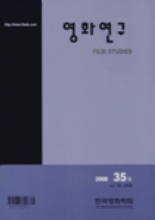- 영문명
- A Study on Possibility of Historicization Category in a Film
- 발행기관
- 한국영화학회
- 저자명
- 전평국
- 간행물 정보
- 『영화연구』제35호, 11~41쪽, 전체 31쪽
- 주제분류
- 예술체육 > 예술일반
- 파일형태
- 발행일자
- 2008.03.31
6,520원
구매일시로부터 72시간 이내에 다운로드 가능합니다.
이 학술논문 정보는 (주)교보문고와 각 발행기관 사이에 저작물 이용 계약이 체결된 것으로, 교보문고를 통해 제공되고 있습니다.

국문 초록
영문 초록
The work of historicization largely comprises the historical narration and the history education. In light of the aspect, history is a crisis. First of all, as the historical narration is the basic problem about the definition dubbed 'what history means', it is related to historical identity. A problem is raised about the scientific historical view, which was defined as 'conversation between the present and the past' based on reality in its previous 'historical fact' due to influence of post-modernism. And, the new historical epistemology is based that is called the component in discourse order, which is formed by the historical narration, simply as text, without being existed the historical fact. Either 'the past fact' or 'historical material' itself is what the current historian cannot actually approach, thereby being unable to see as 'the past reality', and is the result called one 'story', which was decorated with historical imagination. The paradigm conversion is attempted with assertion of being but 'fiction' not 'actuality' while recognizing the so-called historical concept as Linguistic Turn. This is 'anti-history' declaration that rings the knell of history, by regarding even the historical science as the sphere of fiction, not a fact, like literature or art. In the meantime, the evolutionary and progressive historical view is dissected centering on the nation and race, which was pursued by huge discourse in the existing modernism. And, the historical view of pluralism is pointed, which newly arranges history, by finding out discontinuously several starting points, which are made by accidental elements and devious events, for instance, diversely small stories, which are concealed and hidden by huge narration like the life in an individual and the masses, namely, 'history of oblivion' as 'history of memory.' In other words, the masses' counter-memory is reconstituted by excavating history as life, which had been excluded by the history as science. Thus, it aims to seek for the possibility of new history and to widen horizon of historical perception, by creating the so-called 'micro-history' and 'history from below.' Next, a problem of history education results from the perception that only the text history is the true history, with facing the post-alphabet and image era. In the current history-education system that is performed with school education centering on textbook, students or the masses obtain information from internet, film, and TV, not from a book, and communicate with the past. Many masses are already enjoying films or TV historical dramas as one history, naturally acquire historical knowledge inside it, and are renewing historical perception. Furthermore, the film shows specifically several aspects, to which the post-modern historical view had pointed, with diverse elements such as story, video image, color, clothing, art, music, and effect, which hadn't been possessed by the book. Thus, it is becoming the big motive in delivering newly lots of historical facts to audiences and in excavating potential history with historical imagination. One good example is Colorful Holiday, which was greatly successful film in box-office by having been released in the latter half of last year, with the matter of Gwangju on the 18th of May. Ultimately, in order to escape from this crisis, the new conversion of understanding about history is needed. As its one method, the positive attitude and perception are requested, which utilized the image media such as films, TV historical dramas, etc. escaping from 'national history' education centering on the current textbook of having the objective as infusing the national identity and the national ideology. This is the open thinking and the open discourse that elevate the historical thought and the historical imagination, beyond delivering historical knowledge.
목차
1. 들어가는 말
2. 역사란 무엇인가
3. 영화와 역사의 만남
4. 맺음말
키워드
해당간행물 수록 논문
- <케이프 피어>의 리메이크 영화 비교 연구
- 특집 1: 한국영화와 역사학
- 영화의 역사화 범주 가능성에 관한 연구
- 특집 2: 영화서사 및 스타일 분석
- 일제 강점말기 '영화신체제'와 조선영화(인)의 상호작용 연구
- 북한식 사회주의 형성기 북한영화 연구(1958~1966)
- 영화 <꽃잎>과 <화려한 휴가>의 영상재현과 대중의 기억이 구성하는 영화와 역사의 관계에 관한 연구
- 다르덴 형제 영화 연구
- 사단법인 한국영화학회 정관 외
- 기호계의 <향수>, 아브젝시옹의 파랑
- 황석영, 임상수, 그리고 <오래된 정원>
- 이미지 없는 목소리, 아쿠스메트르에 대하여
- 여공, 스크린 재현의 정치학
- 불교영화 <만다라>, <화엄경>, <봄 여름 가을 겨울 그리고 봄>의 불교성 연구
- 한국형 블록버스터 <괴물>의 시각특수효과(VFX)에 대한 연구
- D. 보드웰 어프로치에 의한 서사연구
- 앨프레드 히치콕의 관음증 삼부작
- <베오울프>의 디지털 액터, 리얼리즘, 그리고 사이보그
- 한국영화 배급시장에 관한 연구
참고문헌
관련논문
예술체육 > 예술일반분야 BEST
- 생성형 AI 도구와 디자이너의 협업 프로세스 개발 - 이미지를 통한 아이디어 확산에서 고해상도 렌더링까지
- 디자인 전공 교과목에서의 생성형 AI 도구 활용 사례 연구
- ‘일과 삶의 균형(Work-Life Balance)’ 척도 개발을 위한 연구
예술체육 > 예술일반분야 NEW
- 한국영화의 촬영과 조명 시리즈 2: 영화 '형사, Duelist'의 Visual Concept 및 조명플랜
- 포스트모더니즘적 영상표현에 관한 연구 -실사 영화와 애니메이션 영화의 상호작용을 중심으로-
- 소니 HVR-Z1N 카메라의 중요한 메뉴에 관한 소고
최근 이용한 논문
교보eBook 첫 방문을 환영 합니다!

신규가입 혜택 지급이 완료 되었습니다.
바로 사용 가능한 교보e캐시 1,000원 (유효기간 7일)
지금 바로 교보eBook의 다양한 콘텐츠를 이용해 보세요!



